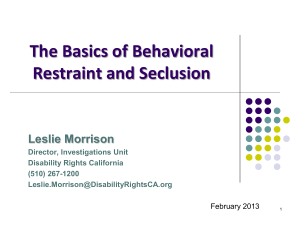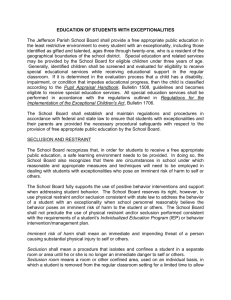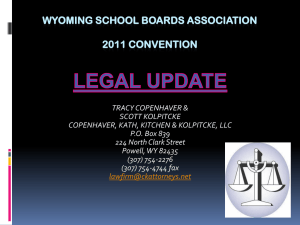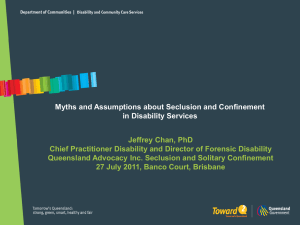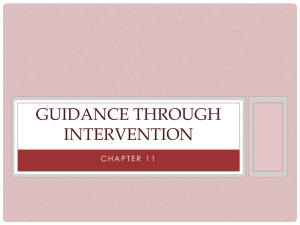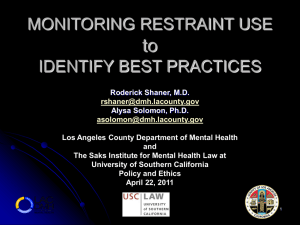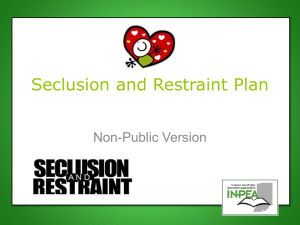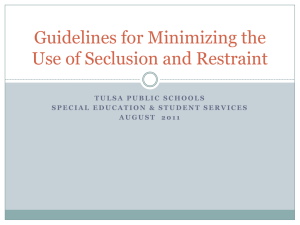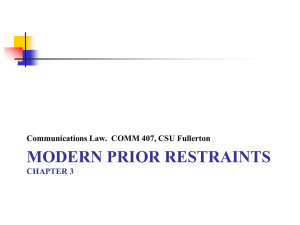RESTRAINT AND SECLUSION - Indiana State University
advertisement
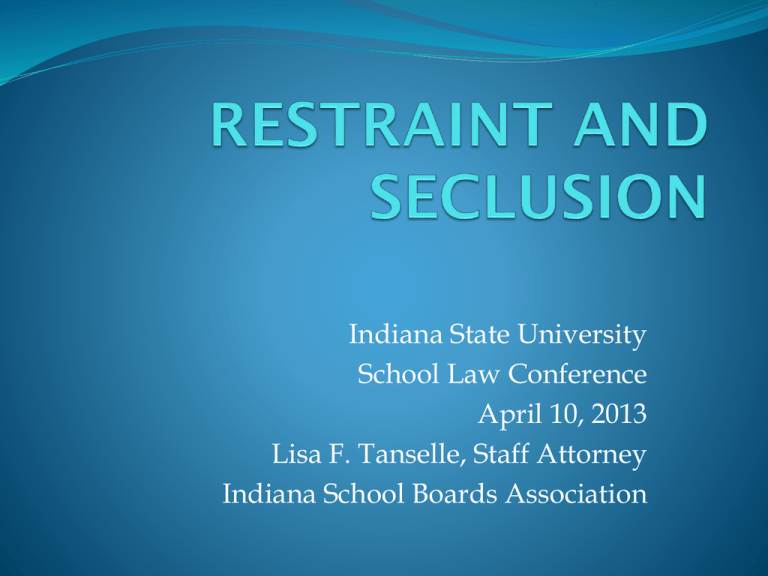
Indiana State University School Law Conference April 10, 2013 Lisa F. Tanselle, Staff Attorney Indiana School Boards Association HISTORY Congressional Research Service issued a report for Congress on the use of restraint and seclusion in public schools, April 2009 U.S. Government Accountability Office conducted and published a study on the use of restraint and seclusion in public and private schools and treatment centers, May 2009 GAO Report No federal laws restricting the use of restraint and seclusion in public and private schools No federal agency or other entity collects information on the use of restraint and seclusion 19 states have no laws or regulations related to restraint and seclusion 10 documented cases of improper restraint/seclusion FEDERAL LEGISLATION Children’s Health Act of 2000 Applies to public and private health care facilities that receive federal funds and other Permits the use of restraint and seclusion in limited circumstances Medicare/Medicaid Regulations Applies to hospitals, psychiatric facilities, and immediate care facilities Permits the use of restraint and seclusion in limited circumstances LEGISLATION AFFECTING SCHOOLS Individuals with Disabilities Education Act Does not mention restraint and seclusion Encourages the use of positive behavioral interventions and supports but does not prohibit the use of mechanical restraints or other aversive behavioral techniques for students with disabilities SCHOOL LEGISLATION Bills have been introduced in both chambers of the United States Congress since 2009 but nothing has been enacted 111th Congress: H.R. 4247, S. 2860, and S. 3895 112th Congress: H.R. 1381 and S. 2020 U.S. DEPT. OF EDUCATION Secretary of Education directed all state school chief officers to review current policies and procedures on the use of restraint and seclusion in schools, July 2009 Encouraged the development and/or revision to help ensure that every student is safe and protected U.S. Dept. of Education published a resource document on restraint and seclusion, May 2012 INDIANA DEPT. OF EDUC. Policy guidance for use of restraints and seclusion issued, December 2009 After finding that Indiana had no statewide policy regarding restraint and seclusion of students, the IDOE developed guidance that recommended schools address the use of restraint and seclusion as part of written discipline rules IDOE GUIDANCE Suggested Elements Circumstances permitting use of isolated time out or physical restraint Written procedures to be followed by staff Designation of school official to be informed of incidents Description of alternative strategies Use of isolated time out or physical restraint as permitted in an IEP IDOE GUIDANCE CON’T. Review and Reporting Suggestions Notification of student’s parent If three incidents of time out or restraint used, school personnel review for effectiveness and preparation of behavior plan Consideration of alternative program or special education referral IDOE GUIDANCE CON’T. Training Requirements Staff training on isolated time out Staff training on physical restraints Appropriate techniques De-escalation techniques and alternatives Description of dangerous behaviors that may warrant restraint Simulated experience of administering and receiving physical restraint Instruction on effects on person, physical signs of distress Instruction on documentation and reporting INDIANA GENERAL ASSEMBLY Engrossed Senate Bill 345 (April 2, 2013) Creates a Restraint and Seclusion Commission Charges the Commission with the duty to adopt rules on the use of restraint and seclusion in public schools, charter schools, and accredited nonpublic schools Requires the Commission to develop a model policy Mandates schools to adopt policies that include all of the elements of the model policy Policies must become effective no later than July 1, 2014 REQUIRED ELEMENTS The Commission’s model policy must include: (1) Statement that positive behavioral interventions will be used first. (2) Statement that behavioral interventions will be consistent with behavioral intervention plans or individualized education plans, if applicable ELEMENTS CON’T. (3) Statement that restraint and seclusion will be used as a last resort and when there is an imminent risk of injury (4) Statement that restraint and seclusion will be used for only a short period of time (5) Documentation of every incident and employee responsibilities ELEMENTS CON’T. (6) Notification to parents, including sending a written report of incident (7) Required recurrent training for designated employees KEY DEFINITIONS Chemical Restraint Administration of drug or medication to manage behavior or restrict freedom of movement that is not a standard treatment and dosage for the student’s medical or psychiatric condition DEFINITIONS CON’T. Mechanical Restraint The use of a mechanical device, material, or equipment attached or adjacent to a student’s body that the student cannot remove and that restricts freedom of movement or restricts normal access to the student’s body. Excludes mechanical restraints used as prescribed by a doctor DEFINITIONS CON’T. Physical Restraint Physical contact in which the student unwillingly participates and that involves the use of a manual hold to restrict freedom of movement or normal access to a student’s body Excludes briefly holding a student without undue force to calm or comfort student, or to prevent unsafe behavior; physical escort; or physical contact intended to gently assist or prompt student in performing a task or guide a student from one area to another DEFINITIONS CON’T. Seclusion The confinement of a student alone in a room or area from which the student is physically prevented from leaving Excludes supervised time-out or scheduled break in which adult is continuously present CASES Barocas v. State, 949 N.E.2d 1256 (Ind.App. 2011) A special education teacher’s action in flicking a student’s tongue, after twice telling the student to put her tongue back in her mouth, was neither cruel nor excessive and was reasonable to control the student’s behavior. Teacher was not guilty of battery, as charged by the State. CASES CON’T. Littleton v. State, 954 N.E.2d 1070 (Ind.App. 2011) Use of a Rifton chair was neither an unreasonable use of force nor based on an unreasonable belief that the action was necessary to protect the student and others. Therefore, the teacher’s conduct was within her duties as a teacher to manage a classroom and entitled her to statutory qualified immunity. CASES CON’T. Loogootee Community School Corporation, CP-037-201 1, Indiana State Educational Agency, December 20, 2010 Teacher’s restraint of student on a school bus was in accordance with the student’s IEP; teacher was certified in Crisis Prevention Intervention and trained in the use of de-escalation techniques; student was at risk of harming himself or others; teacher’s decision to place student on her lap and hold student’s arms at his side did not violate Article 7


